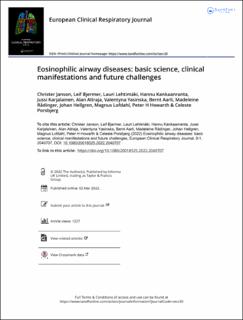| dc.description.abstract | Eosinophils have a broad range of functions, both homeostatic and pathological, mediated through an array of cell surface receptors and specific secretory granules that promote interactions with their microenvironment. Eosinophil development, differentiation, activation, survival and recruitment are closely regulated by a number of type 2 cytokines, including interleukin (IL)-5, the key driver of eosinophilopoiesis. Evidence shows that type 2 inflammation, driven mainly by interleukin (IL)-4, IL-5 and IL-13, plays an important role in the pathophysiology of eosinophilic airway diseases, including asthma, chronic rhinosinusitis with nasal polyps, eosinophilic granulomatosis with polyangiitis and hypereosinophilic syndrome. Several biologic therapies have been developed to suppress type 2 inflammation, namely mepolizumab, reslizumab, benralizumab, dupilumab, omalizumab and tezepelumab. While these therapies have been associated with clinical benefits in a range of eosinophilic diseases, their development has highlighted several challenges and directions for future research. These include the need for further information on disease progression and identification of treatable traits, including clinical characteristics or biomarkers that will improve the prediction of treatment response. The Nordic countries have a long tradition of collaboration using patient registries and Nordic asthma registries provide unique opportunities to address these research questions. One example of such a registry is the NORdic Dataset for aSThmA Research (NORDSTAR), a longitudinal population-based dataset containing all 3.3 million individuals with asthma from four Nordic countries (Denmark, Finland, Norway and Sweden). Large-scale, real-world registry data such as those from Nordic countries may provide important information regarding the progression of eosinophilic asthma, in addition to clinical characteristics or biomarkers that could allow targeted treatment and ensure optimal patient outcomes. | en_US |

